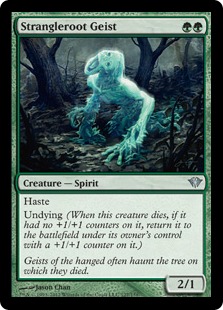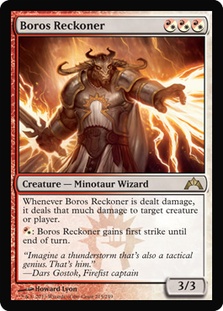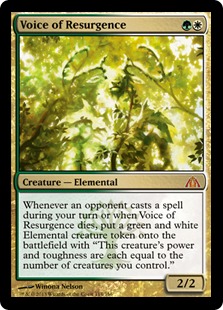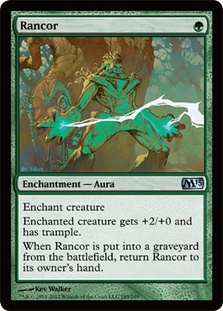It always happens.
Opponent: Burning-Tree Emissary, Burning-Tree Emissary, Burning-Tree Emissary, Firefist Striker. Go.
Me: Burning-Tree… Go?
Always like this.
Opp: Farseek, Hallowed Fountain. Go.
Me: Burning-Tree Emissary, Burning-Tree Emissary, Burning-Tree Emissary, Firefist Striker. Go.
Opp: Supreme Verdict.
I’m done.
No more Burning-Tree Emissary into blank hands.
No more blowouts by spells everyone plays.
I’m sick of it.
Correction, I was sick of it.
Then I found the answer.
Hello my wonderful readers and welcome to my first ever article for StarCityGames.com. My name is Aaron Barich for those of you who didn’t read the title, and I must say it’s an awesome feeling to be able to say that I wrote something for one of the biggest websites in Magic. I live in Gulfport, Mississippi, which is, as the name describes, on the coast. I’m 16, I first picked up a Magic card when I was five, and…
I’m not even going to kid myself. None of you came here to read about me. You all came here to read about this.
Creatures (28)
- 4 Strangleroot Geist
- 4 Dryad Militant
- 4 Loxodon Smiter
- 4 Experiment One
- 4 Ghor-Clan Rampager
- 4 Boros Reckoner
- 4 Voice of Resurgence
Lands (22)
Spells (10)
Sideboard

This is the deck I piloted to back-to-back SCG Standard Open Top 8s in Dallas this past weekend. I’m sure when many people look at this deck their first reaction is, “Strangleroot Geist and Boros Reckoner? This deck looks sweet!” Unfortunately for them, their second reaction is, “Strangleroot Geist and Boros Reckoner? This mana base looks awful!” The reason that’s unfortunate for them is because those people will never get a chance to taste the future until it’s too late.
What future, you ask? The future of Standard!
Don’t let the look of the mana deter you. This deck is the real deal. Those of you who are able to come to terms with that will have a wonderful time where people aren’t prepared for what this deck brings to the table: quick resilient creatures with a powerful game-ending suite.
This deck started with an idea. It was blasphemy, and I had quite a few people tell me it just wouldn’t work. I told them they were wrong. I knew it had to be possible. I knew I had the tools to build it. I knew that the best decks are the ones that don’t get blindsided by the norm and take things in a different direction.
I knew I hated Burning-Tree Emissary.
I remember laughing at all my friends when that card was previewed. They all dreamed of the Champion of the Parish, Burning-Tree Emissary, Lightning Mauler starts. I told them it was too inconsistent to be a tier 1 deck. I told them it wouldn’t happen. No way.
Well, I most definitely wasn’t laughing for long.
Sometimes I feel like Naya Blitz as a deck was created just to break every rule of good aggro decks in the past. You want to be consistent. You don’t want to overextend. You don’t want to play blank Magic cards (I’m looking at you, Burning-Tree Emissary).
Naya Blitz fails on all accounts.
I wanted to build a deck without Burning-Tree Emissary. I hated the card. It went against everything I ever knew about playing aggro, and I wouldn’t stand for it.
I then played R/G Aggro for three months.
I played it until the format became saturated with it. People began to hate out this aggro deck like they did Naya Blitz. So I made some changes, added some white, and splashed some Loxodon Smiters and some Boros Charms to help with the U/W/R control variants that gave aggro fits. I then decided I didn’t like red’s available one-drops and tried swapping them for green’s much more powerful Dryad Militant and Experiment One. It had decent results.
My control and midrange matchups didn’t seem to change all that much, but the increase in quality creatures helped my aggro matchups a decent amount. Making these changes caused Flinthoof Boar to become a 3/3 less consistently, so I wanted to find a replacement for it. With cutting those, I knew Burning-Tree Emissary would be less powerful. I saw this as my chance. I was sick of getting Burning-Tree blank hands, and I wanted a creature that would help more in the midrange and control matchups.
Then I found the answer.
Voice of Resurgence is arguably the best two-drop in Standard. It’s a value creature that lets you know when the coast is clear to do whatever you want to do. It blocks like a champion against aggro decks and doesn’t mind getting blocked when attacking against midrange. After finding this piece, I knew I had a chance to play another one of my favorite two-drops in Standard.
Strangleroot Geist is like a more aggressive Voice of Resurgence. It doesn’t have the same awesome ability to a give you free information, but it makes up for it by being a better creature when you need to quickly kill the G/B/W Reanimator decks. It even let me play more Forests to more consistently hit a turn 1 Experiment One. After this revelation, I came to the single hardest question when building this deck.
Could I play Boros Reckoner with Strangleroot Geist?
I discovered that the answer is yes. I love Boros Reckoner; it’s my favorite creature in Standard. It does everything an aggro deck wants in a three-drop. It’s hard to beat in combat, can get two-for-ones, and pushes through the last few points of damage when needed. There was no way I could cut it from the deck. I looked high and low for a viable replacement, but none seemed to play both offense and defense as well as Reckoner, so I resigned myself to playing him.
I tried to make the mana base as consistent as possible, even trying out Guildgates, but they were quickly thrown out since they were too slow against the aggro decks for me to survive. After goldfishing a bunch of times with a prototype build of the deck, I learned that the mana wasn’t that bad. It was even pretty good! I wasn’t getting hurt by my Sacred Foundrys or Forests as often as I thought I might, and I was even curving Strangleroot Geist into Boros Reckoner almost every time I had them both in hand.
I had a good shell going. Now I needed to fill in the missing gaps.
With green being the primary color of the deck now, Hellrider became too hard to cast. I quickly found Advent of the Wurm as a semi-haste replacement. It also pulled double duty as both an instant speed way to evolve Experiment One and a free removal spell last weekend. Even when they knew it was coming, some decks had trouble beating an end of turn 5/5 trampling Wurm. I thought about running the full set of Advent of the Wurm because it seemed like a very powerful play in the deck, but I was worried about having only eight one-drops and eight two-drops in a deck that’s main plan is still to kill quickly.
I looked through the remains of the other aggro decks I played during Return to Ravnica Standard season and found a card from my original list of R/G Aggro. Rancor is one of the strongest enchantments ever printed and was always a champ when cast on Boros Reckoner, but it felt fragile and was eventually cut. The new deck, however, did not have to worry about such a problem. Voice of Resurgence and Strangleroot Geist both made great targets for my Rancors since I wasn’t two-for-oned if my opponent had the kill spell in response. Voice had the added benefit of giving the same protection to all of my creatures when casting Rancor. This plus the fact that it gave me even more reach in the midrange matchups made it a shoe-in in my new list.
After finalizing what I thought was a good maindeck, I had to craft an equally good sideboard.
I felt that even though I had a powerful creature suite against aggro decks, I didn’t really have a way to rebound from an explosive draw from Naya Blitz or R/G Aggro, so I knew I would have to devote quite a few sideboard slots to help fix that. As the deck progressed, I began to like my midrange matchups a lot more. This stemmed from the fact that even when they cast their supposed “brick walls” (i.e., Thragtusk), my early drops didn’t mind running to their deaths because they’d come back even better! That meant I didn’t have to board nearly as many cards as before for those kinds of decks.
My sideboard plans for each matchup were the following:
Naya Blitz
+3 Pacifism
+2 Mizzium Mortars
-2 Rancor
-2 Boros Charm
-1 Advent of the Wurm
R/G Aggro
+3 Pacifism
+2 Mizzium Mortars
+3 Volcanic Strength
-2 Rancor
-2 Boros Charm
On the play:
-4 Dryad Militant
On the draw:
-2 Dryad Militant
-2 Advent of the Wurm
The value of Volcanic Strength against Naya Blitz over R/G is down by a wide margin due to Pacifism / Fiend Hunter and the lack of blocking that they can actually do profitably. Against R/G, Advent is a powerful tool, but being able to put down more one-drops on the draw is important for stopping Burning-Tree Emissary assaults.
The Aristocrats
+3 Pacifism
+3 Volcanic Strength
-2 Boros Charm
-4 Dryad Militant
I dislike Dryad Militant here because of the ease at which it is stopped by Doomed Traveler, and the ability to stop the flashback of Lingering Souls is not worth keeping the card in this matchup. Pacifism is important for stopping Boros Reckoners and Falkenrath Aristocrats because they are the easiest non Blasphemous Act ways for The Aristocrats to take care of your larger creatures. Watch out, though; a Pacified Boros Reckoner can still mean business if a Blasphemous Act occurs (I learned this the hard way over the weekend).
G/B/W Reanimator
+3 Skullcrack
-2 Boros Charm
-1 Searing Spear
If on Loxodon Smiter:
+2 Mizzium Mortars
The G/B/W Reanimator matchup seems to rely heavily on whether my opponent can Unburial Rites an Angel of Serenity or not. If they are unable to do that, I feel favored. Most G/B/W Reanimator lists board in cheap removal to stop early creature assaults. This plan of action doesn’t work too well against the Strangleroot Geist / Voice of Resurgence deck. While they are durdling around casting Mulches, we’re casting creatures that get them dead.
Jund
+3 Skullcrack
+1 Mizzium Mortars
-2 Rancor
-2 Boros Charm
The addition of the one Mizzium Mortars is a concession to Vampire Nighthawk, and Rancor is bad against a deck packing both Abrupt Decay and Putrefy. This matchup should be slightly favorable unless Jund is able to curve Vampire Nighthawk into Huntmaster of the Fells into Thragtusk, which is too much for even this deck to handle. The biggest thing I learned in this matchup is to not let your three-power creatures get stopped by Nighthawk. Don’t fear trading off even though it feels bad. Your opponent will gain more life from you wasting your time than from the Nighthawk’s lifelink.
Naya
+3 Skullcrack
+3 Volcanic Strength
-2 Boros Charm
-4 Dryad Militant
Dryad Militant quickly gets outclassed by Naya’s three-drops, and it’s very hard to win by speed here. The plan is to get in a few quick hits with our cheaper creatures and then end the game with a Volcanic Strengthened creature shipping in through their defenses. It’s not a perfect plan, but it feels like the one that has worked best so far.
Esper / U/W/R / Bant Control
+3 Skullcrack
+2 Boros Charm
-2 Rancor
-3 Searing Spear
Your plan against the control decks is to either be quick with the beats and have a few of the two-drops deter their Supreme Verdicts or to hit the jackpot. Hitting the jackpot is what my group has called using a Ghor-Clan Rampager plus Boros Charm to double strike for way more damage than your opponent expects. This can usually steal free games from opponents who have to tap out to do different things. I don’t feel like I have a bad matchup against these decks, but I know I can lose to them if I don’t apply enough pressure and let them cast a Sphinx’s Revelation for more than three.
Bant Hexproof
+2 Ray of Revelation
+3 Skullcrack
+1 Boros Charm
-2 Advent of the Wurm
-4 Searing Spear
The goal here is to win the die roll. This matchup is a huge coin flip, and it relies heavily on either curving out and winning while on the play or on drawing Ray of Revelation, which is borderline impossible for them to beat. This is the one matchup where I feel like a slight underdog since I’m not as fast as the other aggro decks in the format and it’s much less likely for me to curve out perfectly. If your metagame has a lot of Bant Hexproof, I could easily see adding more Rays to help shore up this matchup.
I have faith in this deck’s ability, and I believe that it’s the best aggro deck in Standard. For anyone who decides to play this deck, they need to take a pledge.
A pledge to not cast Burning-Tree Emissary in Standard.
Let’s keep those Burning-Trees out of Constructed decks! Let’s not fall for the trap that is the Emissary! Let’s take a stand against the norms of Standard! Let’s burn the Burning-Trees!
Who’s with me?!
Diefi00 on Magic Online and pretty much everywhere else
Thanks to everyone for reading. Questions? Comments? I’d love to hear them. I want to improve as a writer since I love to do it, so any constructive criticism is welcome. [Editor’s Note: You’re off to a pretty good start.]




